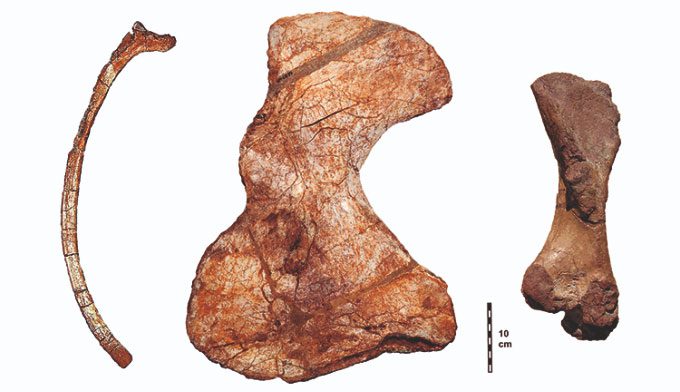Fossilized bones from the Permian period reveal a previously unknown prehistoric animal resembling a hybrid between a lizard and a hippopotamus.

Reconstruction of the newly discovered species Lalieudorhynchus gandi. (Photo: Frederik Spindler)
In a study published in the journal Palaeo Vertebrata last month, paleontologists named the new species Lalieudorhynchus gandi. It lived approximately 265 million years ago on the supercontinent Pangaea and is part of the prehistoric four-legged reptile group known as Caseidae, potentially representing an amphibious species.
The fossils of this creature were excavated from the Lodève Basin in southern France by Professor Jörg Schneider and PhD student Frank Körner from the Department of Paleontology and Stratigraphy at the University of Freiberg, Germany. They discovered two ribs measuring 60 cm long, a scapula measuring 50 cm, and a femur measuring 35 cm.

Ribs, scapula, and femur of Lalieudorhynchus gandi. (Photo: Ralf Werneburg)
Members of the genus Lalieudorhynchus could grow to lengths exceeding 3.5 meters, making them one of the largest terrestrial animals of the Permian period.
This prehistoric group of reptiles had a stout body and a lifestyle similar to that of hippopotamuses (spending part of their time in water and often returning to land to forage), but their heads and tails resembled those of lizards. Microscopic observations indicated that the bone structure of Lalieudorhynchus gandi was more porous and flexible, suggesting they were better swimmers than hippopotamuses.
Lalieudorhynchus is believed to be an ancestor of several mammal species and one of the earliest herbivores in evolutionary history, featuring a barrel-shaped body with large digestive tracts for breaking down vegetation.
“The ancestral group of mammals was highly diverse and dominated the Earth before the age of dinosaurs. This new discovery not only enhances that diversity but also reveals a very important herbivorous species. Lalieudorhynchus gandi may represent the pinnacle of evolution for all Caseidae species before their extinction, meaning it possessed the most advanced characteristics in the group,” Spindler emphasized.





















































